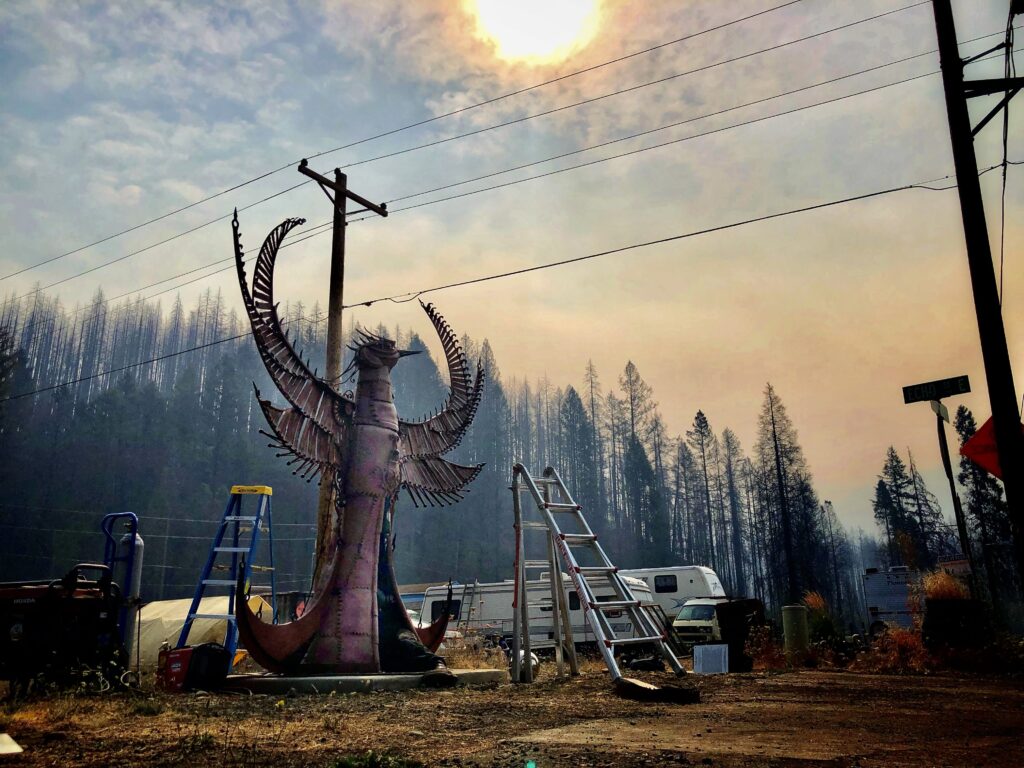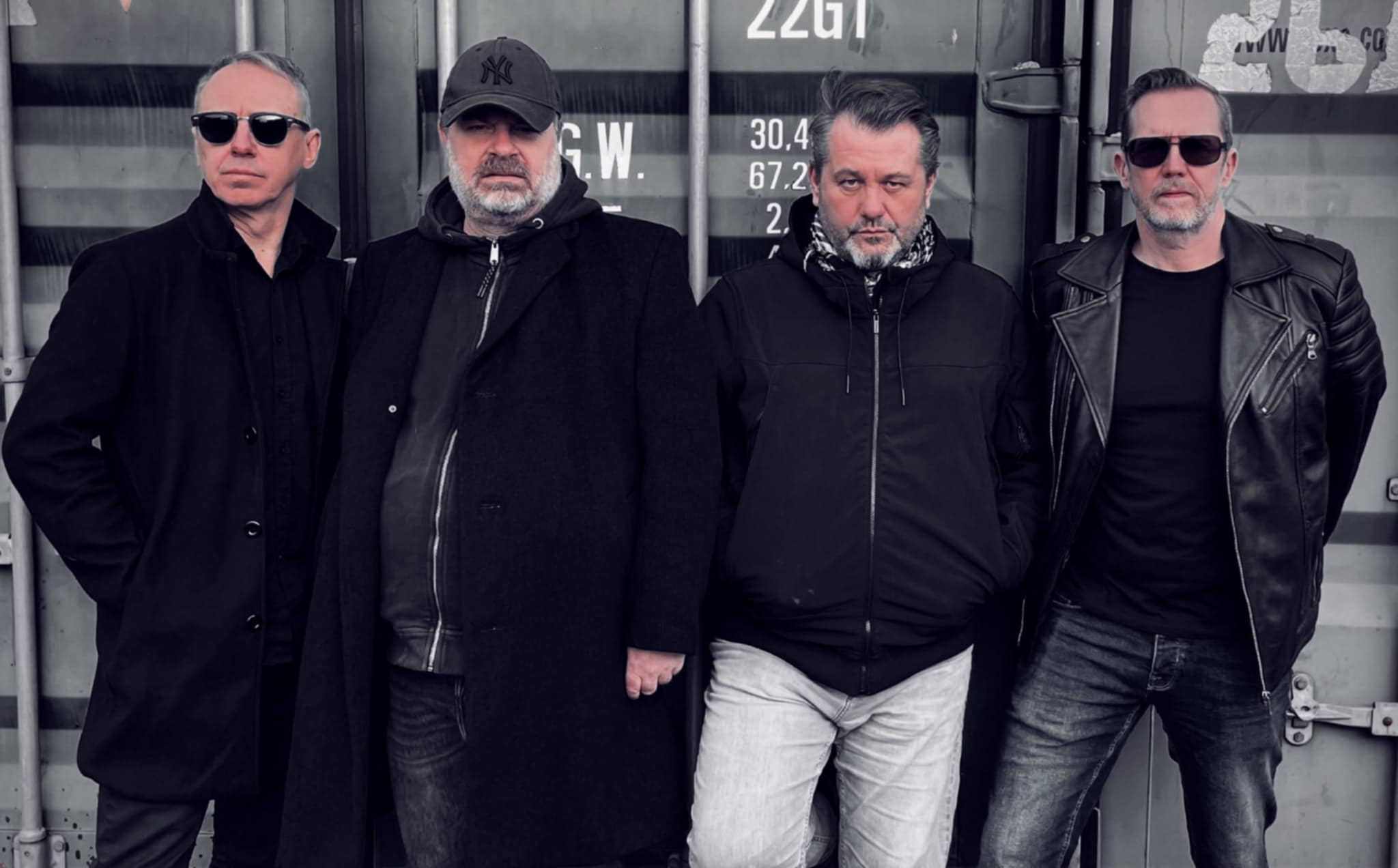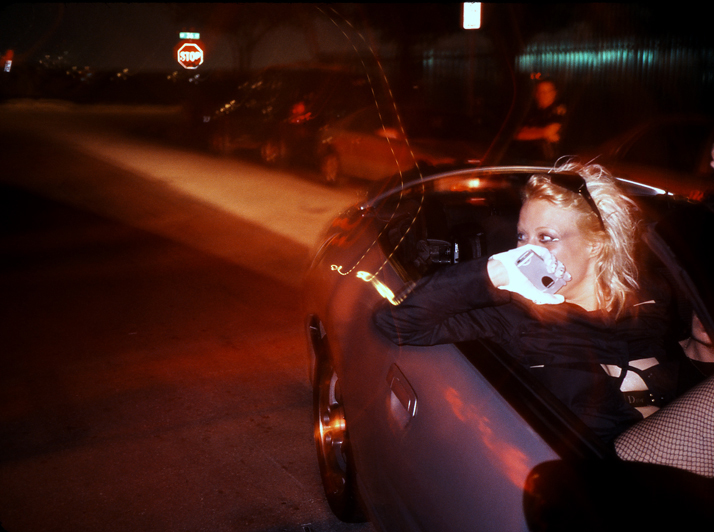(BLUE RIVER, Ore.)— This past Labor Day, an estimated 100 fire trucks, ambulances, water trucks, and personal vehicles rolled through the remnants of Blue River, flashing their lights and blaring sirens. The din resonated through the barren night landscape, which was largely comprised of empty lots and foundations where buildings once stood.
A year earlier, on Sept. 7, the Holiday Farm Fire ripped through this quiet, rural community about 50 miles west of Eugene-Springfield, causing residents to flee with whatever they could throw into their cars. Many escaped the inferno on the rims of their wheels, the rubber melted off in the heat.
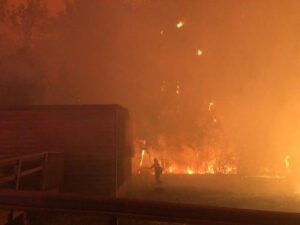
A firefighter battles the Holiday Farm Fire which burned 173,000 acres across the McKenzie River Corridor. Credit: InciWeb
The somber caravan retraced the wildfire’s 27-mile path of devastation through Oregon’s McKenzie River Corridor, which consumed 173,000 acres and an estimated 1,000 structures, half of which were residences. Miraculously, only one person – a man in neighboring Vida – died that night.
VIDEO: Commemorative procession drives through Blue River to mark the anniversary of Holiday Farm Fire.
With wings spread high, a nearly 13-foot tall metal sculpture, Viribus the Phoenix, greeted the procession on a corner across from where Meyers General Store & Liquor Shop once stood.
Installed just 10 days before the commemorative drive, Viribus was designed from scrap metal gleaned from the ruins of Blue River and symbolized resiliency and rebirth.
Behind the scenes, Blue River officials and advocates are admittedly worried about when and how that rebirth will happen.
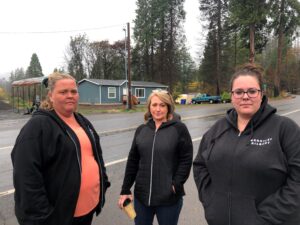
(from L to R:) Blue River stalwarts Melanie Stanley, Jamee Savidge, and Samantha Winningham are devoted to not only rebuilding their town but restoring its core soul by encouraging displaced residents to return. Credit: Brian Bull
“We are one of the most heavily devastated,” said Melanie Stanley, Blue River’s unofficial mayor. While noting other communities suffered damage from the Holiday Farm Fire, she said Blue River’s entire commercial district – including her own business, the general store – was obliterated. As she has wrangled with the county over the permitting process for rebuilding destroyed property like many other locals, she admitted there is some wariness over the town’s future.
“You know, we’ve lost a third of our community…and so, what’s our demographic? Who are we rebuilding for?” she asked.
Addressing Nearly Two Dozen Major Wildfires in 2020
The Oregon legislature allocated more than $600 million towards wildfire recovery efforts this summer – which included $3.5 million towards rebuilding Blue River’s community library and the Upper McKenzie Fire and Rescue station. Additionally, state lottery funds provided more than $15 million more towards rebuilding the community’s water and wastewater infrastructure. But Stanley and other steadfast residents fear that if no one comes back, all that funding will result in a freshly-built ghost town.
Prior to the September 2020 wildfires, Blue River was an oasis of dense forests and steep hills, with the turquoise waters of the McKenzie River winding through towards the larger municipalities of Eugene-Springfield. It held cozy restaurants, folksy grocery stores, rustic cabins, and inns, plus facilities for outdoor enthusiasts that made it an enjoyable escape for tourists.
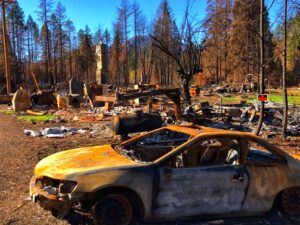
A charred ruin of a Blue River home and vehicle mark where the Holiday Farm Fire laid waste to the rural riverside community. Credit: Brian Bull
By Stanley’s account, between 250 to 300 people initially lived in the Blue River community. Following the Holiday Farm Fire, she figures it’s close to a third of that.
One person who’s moved away is 68-year-old Micki Shampang-Voorhies. She remembered the night of the wildfire, when a neighbor entered her home, yelling at her to get out.
“I was sound asleep with four cats,” she recalled. “It was raining fire. Big balls of fire. So I grabbed the four cats and left, that was it. I lost everything. My home, my shop, everything I owned.”
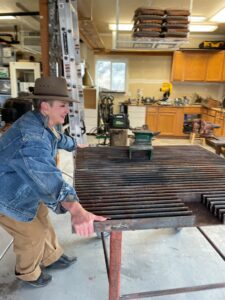
Micki Shampang-Voorhies in her new metalworking shop in Kingston, Nevada, adjusting a new cutting table. She entertains the idea of putting a yurt or cabin on her Blue River property someday, but for now, has left it covered in wildflowers. Photo provided by Micki Shampang-Voorhies.
Today, the metal-working artist lives 600 miles away from Blue River in Kingston, Nevada, where she’s close to her son. She was even “adopted” by another cat within her first week, so now lives with five.
Now comfortably settled in this desert community, Shampang-Voorhies said she’s not going back to the Oregon community she knew for 26 years.
“I did okay with insurance, but the cost to rebuild in Blue River, just a home without a shop or anything, it was way cheaper or about the same amount of money for me to purchase a lodge here in Kingston,” she told The Click.
“And the fear of having to go through a wildfire again, and the permitting and engineering process where they were so far behind.”
The Bureaucratic Slog of Rebuilding
The lengthy permitting and rebuilding process has also stymied 92-year-old Jim Baker, who moved to Blue River in the late 1960s. He became president of several community groups, including McKenzie Guardians, which pushed back against a number of timber sales in the area, and another organization which evolved into the McKenzie Community Development Corporation (MCDC).
“This whole process is torturous,” said Baker, who’s living with a family acquaintance in Ridgefield, Washington, 180 miles north of Blue River. The wildfire claimed his home, the shop, and another cabin near the Finn Rock area of the community. A mobile home rental he owns was also damaged. And while he’s finally gotten a building permit approved, he’s still a ways yet from returning.
“Within a year from now,” he laughed. “I think that there’s just going to be a turnover of people. Some will not come back, it’s just too much to go through. It’s just not worth it for them, but I think other people will come in. It’s still an attractive place to be.”
Among those who plan to stay is Jamee Savidge. She lives with her 11-year-old boy in Blue River and was fortunate to not lose her home to the Holiday Farm Fire. Working with the McKenzie Valley Long Term Recovery Group, she’s seen the frustration and concern many locals have as they try to build back both the town and the community.
“There are two people back in stick-built homes, and I think we have nine in manufactured homes,” she told me in Stanley’s office in early October. The women agreed that besides the lengthy permitting process, contractors and materials are in high demand and short supply.
“If you hadn’t pretty much signed on with a contractor in like, December [2020], you’re fighting right now to try and get anybody,” said Stanley.
Savidge said of the 476 homes in the McKenzie River Corridor lost to the fire, 143 were approved for permits as of Oct. 14, a little more than a year after the incident. And of the roughly 50 homes destroyed in Blue River, about a fifth have been approved for permits.
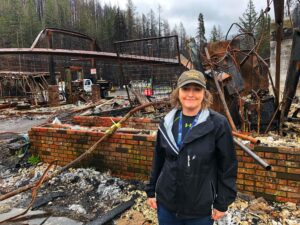
In this Feb. 19, 2021 photo, Jamee Savidge stands before a destroyed business in the process of being excavated and cleaned up, nearly six months after the Holiday Farm Fire leveled the Blue River business district. Credit: Brian Bull
The quandary isn’t necessarily with the 25% of people who lacked insurance or the other 25% who were well-insured, she said. “It’s the 50% in the middle who are still struggling…just trying to figure out how they want to move forward. A lot of those people are stuck waiting on building material prices to come down and then waiting to see what happens with everyone else with their permitting process. Some of those people are still on the fence as to whether they will stay.”
As a parent, Savidge notes that the school and its many activities depended heavily on volunteers. Other places including the library relied on volunteers, and seasonal tourism is also reliant on people.
“It’s very concerning to me that we have such a large number of people that haven’t been able to figure out what they want to do,” said Savidge. “Because of hurdles that keep getting put in front of them.”
An Economic Driver on the Horizon
Legislators have worked to help in the aftermath of the 2020 wildfires across Oregon. Over the past year, state senator Floyd Prozanski has fielded calls and visited Blue River, which is one of two areas in his legislative area affected by the 2020 wildfires (another incident, the Archie Creek Fire, destroyed 118 structures, most of them homes). Besides supporting bills that have addressed wildfire risk management and reconstruction, the Democrat is also expressing support for a new educational facility called the McKenzie River Discovery Center. Prozanski and other advocates say it would draw as many as 50,000 visitors a year and generate $7 million to the region, including Blue River.
“This will be one of those springboards of really getting people back into the valley upriver, doing hikes, the mountain biking that’s available up there, you’ve got of course the various falls for people for trekking,” said Prozanski. “Then of course hotels, restaurants, all of that’s going to benefit.”
The immediate catch is that even if funding and support come through, the site wouldn’t open until 2025. Prozanski acknowledges that for a community like Blue River, those rewards seem especially distant.
“The encouragement is just looking at what they’ve already done for themselves and their community, and their families, and their friends,” he said. “There is a particular type of individual who lives in these types of communities and they want to be back there. At least the individuals I’ve talked to.”
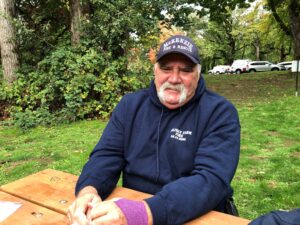
Dana Burwell, a fire battalion chief with McKenzie Fire & Rescue for more than four decades, says many friends and neighbors are considering staying out of the area hit by the Holiday Farm Fire. Credit: Brian Bull
There are those who’ve had enough, though. Dana Burwell lives in the neighboring town of Leaburg and knows of 10 people in his circle who’ve lost homes to the Holiday Farm Fire.
“A lot of the people that I went to school with have just decided that they don’t have the energy or the effort to rebuild now,” he said. “They want to move closer to their kids and be closer to their grandkids, and they can just buy a house with their insurance money somewhere else and not have to go through all this long, drawn-out process of trying to clean up their lots and then get all the permits and then try and find builders. Builders are very hard to find right now. And it’s just emotionally draining to go through all that effort to try and come back to the same area.”
Burwell himself plans to stay. Come April he’ll mark 45 years as a battalion chief for McKenzie Fire & Rescue. Many residents stay for the sense of community and the natural beauty the valley has, even after the fire rendered much of its forests black, spindly remnants across barren hillsides.
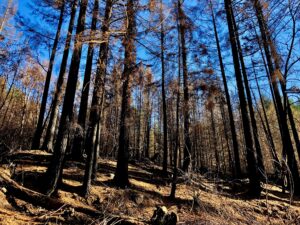
Once a lush and densely forested hillside, this patch of land in Blue River will take time to regrow vegetation and heal. Despite the vast destruction of the 2020 Holiday Farm Fire, interest in the area’s lots and properties remains strong. Credit: Brian Bull
“Due to the Holiday Farm Fire, a lot of attention has been brought to the McKenzieRiver communities,” said Judy Casad, a real estate broker with Windermere Real Estate. She said the area’s beauty, immense watershed, and recreational offerings have created a huge demand for sales and building.
“Demand brings value. Therefore buyers are willing to pay a substantial amount more than before the Holiday Farm Fire.”
That’s reflected in the realtor’s year-long analysis which ended in Nov. 2021. While lack of inventory has brought down sales of residential properties by more than 14%, the average active price is up by nearly 16%. And days on the market went from 136 to 50 days. In that same period, Casad said vacant land sales rocketed up 262%, and average prices went up 93%.
Rebuilding a Town but Preserving Identity
If Blue River’s original inhabitants stay away, new people drawn to the wilderness haven who can readily afford the real estate could move in. They would not have the history or familiarity that long-timers including Stanley have. She fears that would forever change the character of the riverside community she’s loved and cared for as its unofficial mayor.
“It will not be about community, it will not be the heart of the McKenzie. It will not be anything close to what it’s been or what people think it should be,” Stanley said, her voice shaking. “It will be commercialized, it will be gentrified. It will be…not Blue River.”
Stanley draws hope from 27-year-old Samantha Winningham, whom she helped raise and considers family. Winningham, a high school volleyball coach and volunteer firefighter, worked in Stanley’s liquor store. She fought the wildfire that consumed her town, and as a result, had no time to evacuate her home and lost everything. But she says she plans to come back and rebuild with her daughter, fiancé, and their two cats. They’re all currently staying in a trailer up at a friend’s place in Rainbow, up Highway 126.
“I always used to tell people that why would I want to live anywhere else because I live where people want to vacation,” she said, smiling. “And I think that that’s still kind of true.”
Winningham said she doesn’t recall much of the chaotic night when she and other firefighters battled the Holiday Farm Fire, though “I remember it being a lot of crying and throwing up over the guardrail.” She’s focused more on the future, and now works with the non-profit Cascade Relief Team that’s coordinated a lot of cleanup efforts across the community.
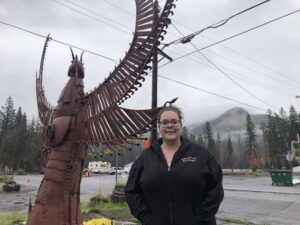
Samantha Winningham is a Blue River resident who lost everything to the Holiday Farm Fire but is ready to return and rebuild with her family. Credit: Brian Bull
There is no formal, organized campaign to get Blue River’s original residents back. But standing a few paces away from Viribus the Phoenix, overlooking the barren foundations of the community, Winningham is optimistic that many locals will eventually come home.
“I know a couple of people that are like, ‘I want to let the area kind of regrow and heal and then we’ll rebuild,’ and I think they’re just not sure what direction to go,” she told The Click. “So as people like us that are moving home and rebuilding businesses and rebuilding homes, and setting the stage, I think it’ll make it easier for other people to feel like they can do the same.”
